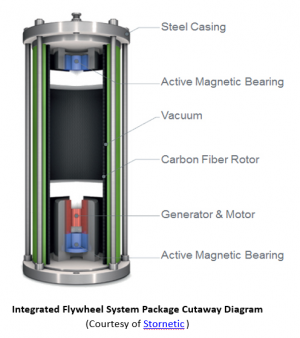Difference between revisions of "Flywheel Energy Storage"
Jump to navigation
Jump to search
m (1 revision imported) |
|||
| Line 1: | Line 1: | ||
{{Energy Storage Technology Simple | {{Energy Storage Technology Simple | ||
|imgdesc=Cross section of a flywheel module | |imgdesc=Cross section of a flywheel module. Courtesy of Stornetic. | ||
}} | }} | ||
| Line 8: | Line 8: | ||
|Has Efficiency Range=85-90% | |Has Efficiency Range=85-90% | ||
|Has Cycle Life=>100,000 cycles | |Has Cycle Life=>100,000 cycles | ||
|Has | |Has Technology readiness level=7 - Deployed | ||
|Has Benefits=* | |Has Benefits=* Fast response time | ||
*High power | * High power capability | ||
|Has Challenges=*Low energy | |Has Challenges=* Low energy capacity | ||
*High self discharge | * High self discharge rates | ||
|Has Application=Power quality, frequency regulation, wind generation stabilization; high energy flywheels for longer duration applications | |Has Application=Power quality, frequency regulation, wind generation stabilization; high energy flywheels are being developed for longer duration applications. | ||
|Has image=File:FlyWheel.PNG | |Has image=File:FlyWheel.PNG | ||
|Has Installed Capacity=~60 MW | |||
}} | }} | ||
Latest revision as of 09:14, 23 December 2021
